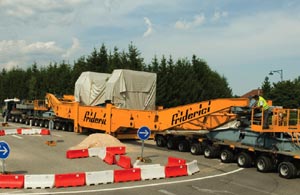July saw some major manoeuvres for the CMS detector, as the collaboration prepares to lower it into its final position on the Large Hadron Collider (LHC) at CERN. The two Forward Hadronic Calorimeters (HFs) were transported from CERN’s Meyrin site to the surface assembly hall at LHC Point 5 in Cessy, France, during the first part of the month. Then, on 24 July, the CMS magnet yoke was fully closed and locked for the first time.

Transporting the two HFs, which each weigh about 300 tonnes, involved constructing a 65 m trailer around them, which was simultaneously pushed and pulled by trucks at either end. The main road between St Genis, close to CERN, and Cessy was closed during each operation and the police escorted the trucks during each five-hour long journey.
The HFs will be the first major elements to be lowered into the underground experimental cavern by gantry crane near the middle of September. In the meantime, the 11 large elements (six endcap disks and five barrel wheels mounted with muon chambers) that form the magnet return yoke were closed together for the first time on 24 July, to allow the tests of the giant solenoid to begin (see CERN Courier July/August 2006 p28). During this process all the yoke elements were precisely aligned with respect to the magnetic axis. The closing procedure was initially quite time-consuming, but progress became quicker with about one working day required to close and lock each element. This is close to the design goal of half a day for each element.





